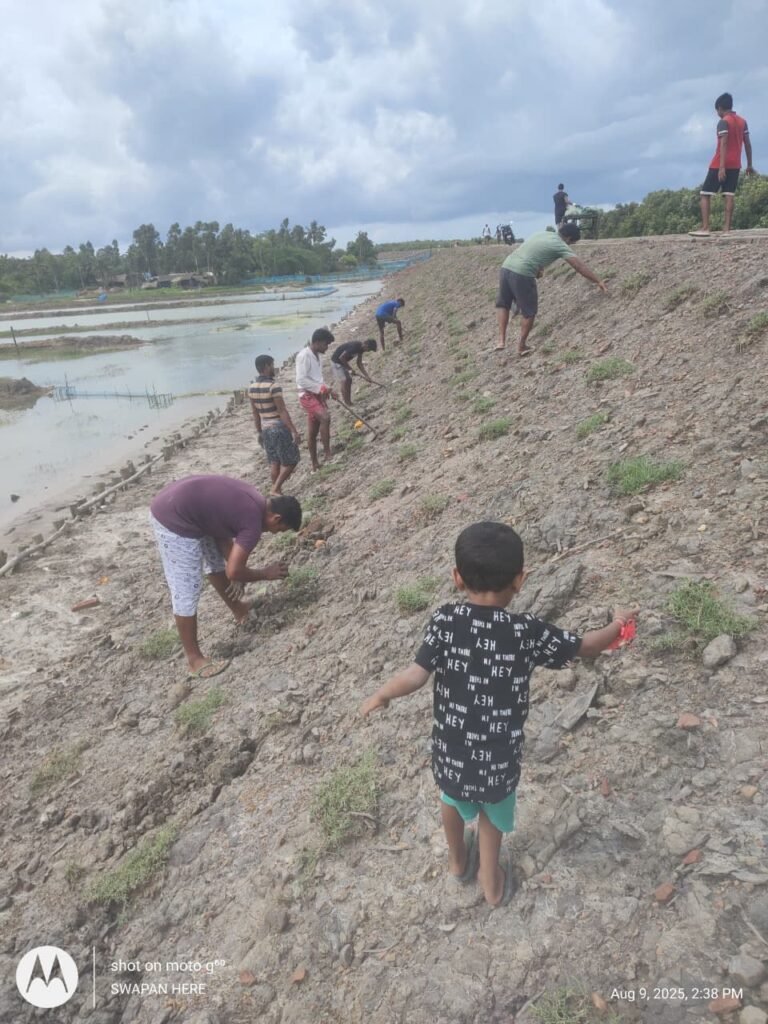
Palm Tree Plantation
Objective:
- To protect the wall and nearby communities from the impact of annual cyclones in Sundarbans.
- To promote sustainable livelihoods and environmental conservation through palm tree plantation.
- To contribute to environmental sustainability by reducing carbon footprint and promoting biodiversity.
- To empower local communities through skill development, employment, and income generation.
Why Palm Tree Plantation?
- Palm trees are a natural barrier against cyclonic winds and storm surges.
- They are high and strong, reducing the force of cyclonic winds and protecting nearby communities and infrastructure.
- Palm trees are never broken, ensuring a long-lasting natural barrier.
- Palm fruit is a high-value product in the market, providing a significant source of income for local communities.
Project Description:
- Plantation of 1,000 palm trees on the opposite side of the riverbank, adjacent to the wall, to act as a natural barrier against cyclonic winds and storm surges.
- Selection of palm tree species suitable for coastal areas and able to withstand high winds and saline conditions.
- Involvement of local communities in the plantation and maintenance process.
- Training and capacity building for local communities on sustainable palm tree management and cyclone risk reduction.
Environmental Benefits:
- Carbon Sequestration: 1,000 palm trees will absorb approximately 200 tons of carbon dioxide annually, contributing to reducing greenhouse gas emissions and mitigating climate change.
- Biodiversity Conservation: Palm trees will provide habitat for various bird species, insects, and small mammals, promoting local biodiversity.
- Soil Erosion Prevention: Palm tree roots will hold soil in place, preventing erosion and landslides.
- Air and Water Purification: Palm trees will absorb pollutants and sediments, improving air and water quality.
Social Benefits:
- Employment Generation: Palm tree plantation and maintenance will provide employment opportunities for local youth and women.
- Skill Development: Training and capacity building programs will enhance the skills of local communities in sustainable palm tree management and cyclone risk reduction.
- Income Generation: Palm tree products (e.g., palm oil, palm leaves) will provide an additional source of income for local communities.
- Community Engagement: Involvement of local communities in the project will foster a sense of ownership and responsibility towards environmental conservation.
Project Components:
- Site Selection and Preparation: Identification of suitable sites on the opposite side of the riverbank, adjacent to the wall; clearance of land; preparation of soil for plantation.
- Palm Tree Plantation: Plantation of 1,000 palm trees adjacent to the wall, with a density of 100 trees per hectare.
- Maintenance and Monitoring: Regular monitoring and maintenance of the palm trees, including pruning, fertilization, and pest management.
- Community Engagement and Training: Training and capacity building for local communities on sustainable palm tree management and cyclone risk reduction.
First NGO Initiative in Sundarbans:
- Sukher Swarga Foundation is the first NGO to initiate a palm tree plantation project in Sundarbans.
- Our project aims to set a precedent for environmental conservation and social empowerment in the region.
- We are committed to working with local communities and stakeholders to ensure the success and sustainability of the project.
Why in River Wall beside in Sundarbans?
- The Sundarbans is a cyclone-prone area, and the river wall is critical infrastructure that protects nearby communities and ecosystems from cyclone impacts.
- Planting palm trees beside the river wall will provide additional protection against cyclonic winds and storm surges, reducing the risk of damage.
- Palm trees will stabilize the soil and prevent erosion, ensuring the long-term sustainability of the river wall.
- The palm tree plantation will contribute to the conservation of biodiversity in the area.
Project Beneficiaries:
- Local Communities: 500 families will benefit through employment opportunities, improved livelihoods, and environmental sustainability.
- Small-Scale Farmers: 200 farmers will gain training and support for sustainable agriculture practices.
- Rural Youth: 300 youth will receive skill development and employment opportunities in plantation maintenance and eco-tourism.
- Women’s Groups: 100 women’s groups will benefit from training and support for sustainable livelihoods and environmental conservation.
- Local Wildlife: The project will enhance local wildlife conservation by creating habitats. Sundarbans First NGO in Sundarbans plants palm trees plant. Largest NGO in Sundarbans palm tree plantation. TOP 10 NGOs in Sundarbans. Sukher Swarga Foundation, First Sundarbans NGO. #SukherSwargaFoundation. #PalmTreePlantation #MangrovePlantation






Recently Completed




